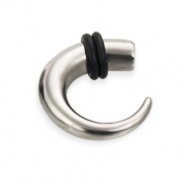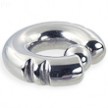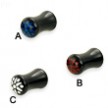2 gauge steel claw
- Diameter: 9/16" (14mm)
- Gauge (Thickness): 2 (6.5mm)
- Material: 316L surgical grade stainless steel
- Type: talon
- -: priced and sold individually
- -: O-rings included
| Click on the picture to see a big picture and description of the body jewelry you are interested in. | |||||||||
|---|---|---|---|---|---|---|---|---|---|
|
Fancy 2 notch captive bead ring,...
$14.49
Fancy 2 notch captive bead ring, 0 ga
|
Pair Of Buffalo Horn Saddle Plugs...
$11.99
Pair Of Buffalo Horn Saddle Plugs with Hand-Carved Buffalo Bone Floral Inlay
Please be advised that there may be some variance in color and tone, due to the product being made from raw, natural materials. |
Acrylic flower plug, 4 ga
$7.24
Acrylic flower plug, 4 ga
|
Black Titanium Anodized Screw-Fit Tunnel with...
$10.49
Black Titanium Anodized Screw-Fit Tunnel with Gecko
|
||||||
TONGUE
Tongue piercings are usually placed in the center of the tongue. The risks of nerve and blood vessel damage are minimized when the piercing is placed centrally. The large blood vessels are usually highly visible to either side, on the underside of the tongue. Tongue piercings are not known to affect the sense of taste; the papillae (tastebuds) are too numerous. Placement should be decided with regard to the length of the tongue both in its normal resting position in the mouth as well as when it is extended.
While there is some latitude as to how far forward or back the piercing can be placed, a piercing made through or just behind the natural bend in the tongue is usually most comfortable for speaking and eating. A piercing placed too far back may be uncomfortable and will irritate the frenulum, if one is present. If the piercing is placed too far forward the bottom ball will irritate the gums.
The piercing should be as perpendicular to the tongue as possible. An extremely slanted piercing (top hole further back than bottom hole) creates stress on the entrances which can result in scarring. A slanted piercing often pushes the bottom ball against the gums causing irritation and erosion of the gums.
The bottom of the mouth or lower gums may become irritated from pressure and friction exerted by the bottom barbell ball. Irritation is usually eliminated by shortening the barbell. If the ball continues to rub against the gums after the barbell is shortened a smaller ball or disc with rounded edges should be worn. If the piercing is too close to the tip of the tongue or slanted the ball will rub against the gums regardless of the ball size. Over the long term continued pressure will cause erosion of the gums and possibly bone loss beneath the gums, indicated by an indentation in the gums.
Chipped and cracked teeth and enamel erosion are risks of tongue piercing. Wearing smaller balls, in addition to downsizing the bar length, is advised if the wearer accidentally bites down on the balls while eating. Over the long term metal tongue jewelry will contribute to the erosion of tooth enamel as the balls hit and scrape the teeth. Cracked and badly chipped teeth are subject to accelerated decay and exposure of the nerve (root) which could require endodontistry (root canal). The risk of damage is increased if the teeth are already structurally weakened by large fillings or caps.
The frenulum is the web of tissue which runs lengthwise along the underside of the tongue, usually present in most people to some degree. Piercing through the frenulum often leads to scarring. If a frenulum is presnt the piercing should be made in front or to the side if possible. If the frenulum is large or extrudes it may become irritated by the jewelry enough to create scar tissue. A smaller bottom ball can reduce irritation.
If the frenulum presents too much difficulty in placement the piercee should consider having the frenulum clipped by a dentist or oral surgeon. This procedure is commonly performed when the frenulum interferes with speaking or some other daily activity.
Tongue piercings made through the front and side edges of the tongue using rings have been successful for some people, but for most people a ring impedes eating and speaking. The wearer is more likely to accidentally bite down on a ring. A ring may rub against the gums, resulting in gum irritation. If such a piercing is desired it is important to use a ring large enough to allow for swelling; a ring which hugs the edge of the tongue may cause migration or scarring. A smaller ring may be worn after the piercing has healed.
Initial jewelry: Barbell studs; 14 to 10 gauge, 5/8» - ¾» - 7/8» - 1» in length. Many piercers will not use 14ga or even 12ga because of the risk of tearing the piercing. During the first 24 to 48 hours the tongue usually swells to almost twice its normal size. The initial stud should be at least ¼» to 3/8» longer than the tongue at its thickest to accommodate swelling. Too short a barbell can make the balls «nest» into the tongue.
Standard ball sizes for 14 and 12ga are 7/32» or ¼»; for 10ga, ¼». 3/16» balls are available from most manufacturers for 14 and 12ga.
The barbell may be shortened after the swelling immediately around the piercing has gone down, usually after 2 to 4 weeks. Shortening the jewelry usually corrects any speech or eating impediments. Some people choose to wear their «starter» barbell with no problems at all.
If the piercing has not healed enough along the inside to rely upon to stay open the jewelry should be changed with the aid of an insertion taper so that the piercing is not left empty. The existing barbell should be pushed out with the taper and the taper pushed out in the same direction with the new jewelry.
Jewelry which is internally threaded at both ends allows for easy insertion and removal. Internally threaded barbells are easily and securely inserted upon piercing using a short piece of wire or a threaded taper to connect the barbell and needle. Barbells with one fixed ball should not be used; the bottom ball can adhere to the shaft with plaque making removal difficult or impossible. Externally threaded jewelry can irritate or tear a piercing, even after the piercing has healed.
A slight indentation usually forms under the top ball, particularly if the tongue rests against the roof of the mouth. A slight indentation under the top ball is not unusual. If the indentation covers half or more of the ball or forms a pocket around the ball the barbell is probably too short to accomodate swelling and / or the piercing is slanted (top hole further back than bottom hole).
Occasionally a protrusion of soft, white hypertrophic scar tissue will form around one or both entrances during the healing period. Scar tissue is not a sign of infection.
- Scar tissue can result from:
- a displaced or intersected taste bud or from tissue displaced by the crescent-shaped hole left by the piercing needle.
- stress caused by playing with the barbell while the piercing is healing or playing too hard for the gauge to endure; 14 and even 12ga piercings have been known to tear or stretch forwards if the piercing is abused
- stress caused by excessive length of the barbell if the barbell leans when the mouth is closed
- stress caused by the piercing being placed at an inappropriate angle; the piercing should be perpendicular to the tongue and not slanted
- friction against the frenulum
- plaque accumulation
- chemical irritation caused by the alcohol present in many mouthwashes, overusing mouthwash or disinfectant; sensitivity to carbamide peroxide, smoking, certain foods
Often, scar tissue recedes into the piercing as the piercing heals or after the barbell is shortened. Continue cleaning the piercing as suggested by your piercer for the remainder of the healing period. If you are using Listerine switch to an alcohol-free or reduced-alcohol mouth rinse such as Biotene or Oral-B. The alcohol in Listerine could be a source of irritation.
Scar tissue caused by friction against the frenulum or by the piercing being placed at an inappropriate angle may not recede and may worsen. Scar tissue that is persistent or grows larger after the piercing has healed may not recede unless the jewelry is removed. Extreme or persistent scar tissue may need to be removed by a dentist or oral surgeon.
Some people successfully use an aspirin and water paste to dissolve the excess growth if less harsh methods are unsuccessful. However, aspirin can seriously damage oral tissues if left in place too long.
Tongue barbells will collect plaque, usually on the bottom ball, especially in the crevice between the ball and bar. Plaque traps bacteria and can cause the jewelry to have a bad odor. Daily use of an anti-plaque rinse is suggested to prevent plaque build-up. To remove a build-up of plaque, remove and soak jewelry in an antibacterial denture cleaner following the package directions.
Check the tightness of tongue barbell balls daily to prevent losing or swallowing the jewelry. Ask your piercer if your barbell is threaded at one or both ends and if it is internally or externally threaded. Ask your piercer to show you the barbell prior to insertion. Ideally the threads should be at least three rotations and should fit securely. Swallowed jewelry usually passes within 3 days.




